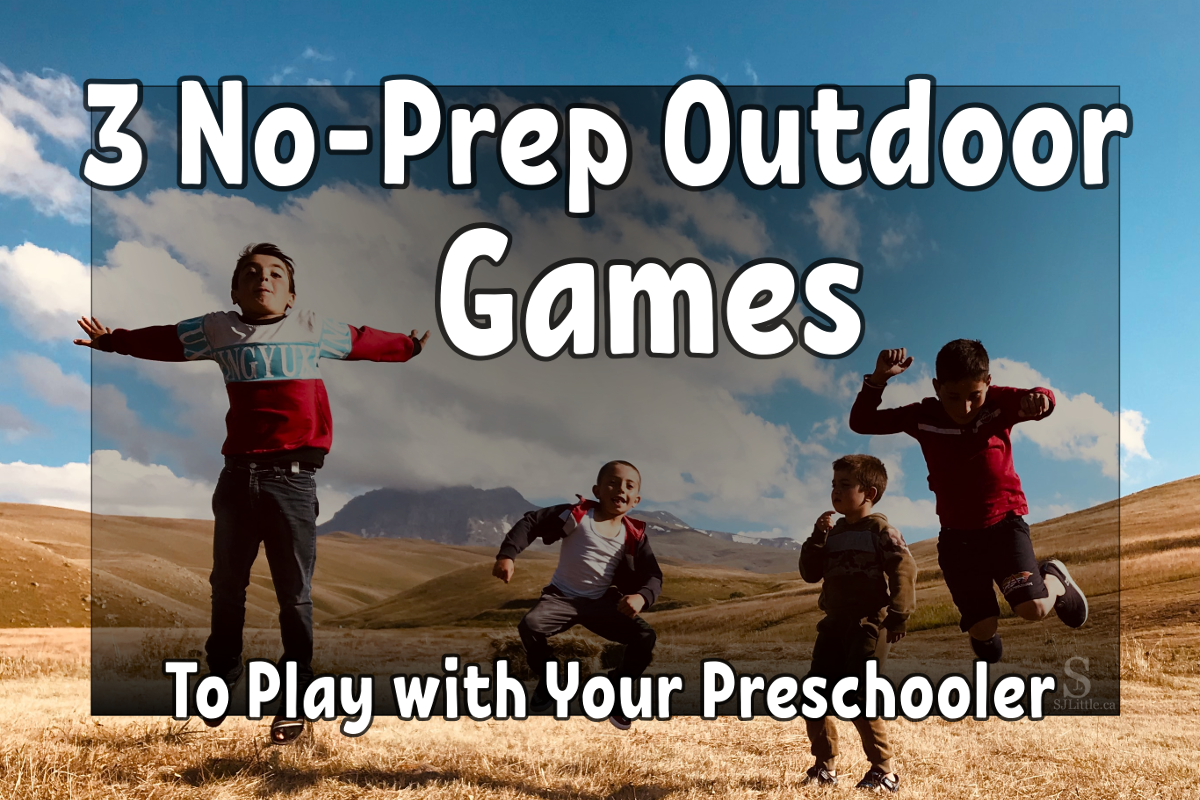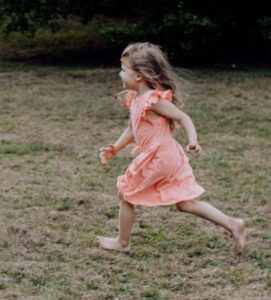
As the weather gets warmer, it’s valuable to get kids outside and moving. That’s what these classic 3 games are all about. Best of all, they are no-prep outdoor games so you can play them just about any time and anywhere.
You may already be familiar with some of these games. Perhaps you played them as a child. I know I did. Whatever the case, if you’re looking for more games to play with your preschooler, keep reading.
Tips for No-Prep Outdoor Games
Before we get into the games themselves, I have a few tips for you.
- Keep a close eye on the children’s interest level. Try to end the game just before the children begin feeling bored. This way, they will remember it as a fun game. If you wait until they are extremely tired and bored, they are less likely to enjoy the game again in the future.
- Choose a playing space based on the age and stamina of your children. For older children choose a larger playing area, for younger children, a smaller space will do. You could use a field, your backyard, a multipurpose room, or a patio (with good railings). Get creative.
- Have fun! If you are enjoying the game your child is far more likely to have fun playing.
What Time is it, Mr. Wolf
Even if you don’t know this game, there’s a good chance your children might. This game can be used in a variety of settings, including swimming lessons and skating lessons.
Number of Children:
- Large group
- Small group
- One-on-one with an adult
Child Development:
- Counting
- Gross motor movements (running and stepping)
- Turn-taking (waiting for their turn to be the wolf)
- Following instructions
How to Play:
Select one person to be the “wolf”. Have them stand on the opposite side of the playing space. Have the other players line up side by side on the starting line.
Together, all the players (except the wolf) call, “What time is it, Mr. Wolf?”
The wolf calls back a number between 1 and 12, or “Lunchtime!”
If the wolf says, “It’s 3 o’clock,” all the players take three steps toward the wolf.
Then all the players ask again, “What time is it, Mr. Wolf?”
Whenever the wolf chooses, he can reply, “Lunchtime!” When he does, the wolf chases all the players back to the starting line.
If the wolf tags anyone before they reach the starting line, they become the wolf. For small groups of 8 children or less, just the person who was tagged first becomes the wolf and the first wolf becomes a player. For larger groups, every child who is tagged joins the wolf so that, as the game progresses, there are more and more wolves and less players.
For older children, have the wolf turn around so that they cannot see how close the players are getting. This is not necessary for preschool children and it can be tricky to keep them from peeking.
Red Light, Green Light
Fantastic for use while teaching transportation or safety themes, this game is well-loved and for good reason. While this game absolutely works without any prep, it can be improved by choosing something to use as the “red light” and the “green light”. In the past, I have used printed stop and go signs, blank red and green pieces of construction paper, red and green hula hoops, red and green cones, or whatever else I had on hand.
Number of Children:
- Large group
- Small group
- One-on-one with an adult
Child Development:
- Gross motor movements (running and stopping)
- Ear-body coordination (hearing instructions and obeying them)
- Listening skills (learning to respond to “stop” or “red light”)
How to Play:
Choose who will be the “caller”. The caller can be a child or a teacher/parent. Have the caller stand on one side of the playing space. Have all the children stand side by side on the opposite side of the playing area.
When the caller says, “Green light!” all the players run toward the caller. When the caller says, “Red light!” all players must stop where they are. The caller continues to call “red light” and “green light” until all the players reach where the caller is standing. Then a new caller is selected and all the players return to the opposite side of the area.
For 8 or fewer children, allowing the children to be the caller works well. For bigger groups of preschool children, it may be best to only have the teacher be the caller. This is especially helpful if you are under tight time constraints. When the teacher is the caller they can control the game. For example, they can make it shorter if gym time is almost over.
For elementary aged children, this game becomes a challenge to not be caught moving when it’s a red light. If caught moving, they are sent back to the start line. For preschool children, remembering to follow the instructions is often exciting and engaging without being sent back to the beginning. However, if a child really isn’t responding to the red light, sending them back to the starting line will help them be more intentional to pay attention next time.
Extend the Fun:
- Extend the fun by adding more colours. This works especially well if you have visuals to hold up for each colour. Some ideas include:
- Orange = go slow
- Blue = (stop and) turn around
- Purple = hop
- Are you doing a transportation or safety theme? Try making visuals representing the stop and walk crosswalk signals to help children learn what they mean.
Mother May I
I recommend this game for a small group of 3-5 children who are aged 3-5. This is due to how slow the game can be when each child moves separately. For larger groups, try having all the children take the steps together, much like What Time is it Mr. Wolf.
As an adult, this game may seem pointless, but many children love it. They enjoy having the power to make choices when they are the “mother”. Be careful to ensure that every child has a turn to be the mother.
If you are uncertain about using this game’s traditional name “Mother May I” try calling it something like “Monkey May I”.
Number of Children:
- Small group
Child Development:
- Variety of gross motor movements (large steps/small steps, and if extending the play: jumps and turns)
- Turn-taking (waiting for their turn to ask to move and to be the mother)
- Making choices (preschoolers love being able to choose and that’s why this game holds appeal for them)
- Counting
- Following instructions (if extending the play, following 2-step directions)
- Good manners
How to Play:
Select one child to be the mother. The rest of the children line up on one side of the playing space while the mother stands on the opposite side.
For this game, each child has a turn to ask the mother what number of steps they can take. Typically, I limit the number to anything between 1-12. Have the first child ask, “Mother, may I take 3 steps?”
The mother gets to choose. They can say, “You may,” at which point the child who asked moves the prescribed number of steps. Alternatively, the mother can say, “No.” If the mother says, “No,” she must then tell the child how many steps they may take, for example, “You may take 2 steps.” The child who asked will then take only 2 steps forward.
Following that, it is the next child’s turn. Continue giving the children turns. The game ends when a child reaches the mother. Then choose another mother and have all the children go back to the starting line.
Again, I stress that when playing this game, it is very important to give every child a turn being the mother.
Extend the Fun:
Once the children have played several rounds, change things up by describing the type of step. “Mother, may I take 1 giant leap?” “Mother, may I take 12 tip-toe steps?”
Ideas include:
- Tiny steps
- Giant steps
- Small hops
- Big jumps
- Backwards steps
- Tip-toe steps
Final Thoughts
Do you have older kids? For groups of children aged 4-10 I recommend the game: Farmer Farmer. It is similar to British Bulldog, but with a twist.
What other no-prep outdoor games do you enjoy playing with your preschoolers?
Do your preschoolers still have energy? Great! Here are two other ideas to help you keep them moving:

